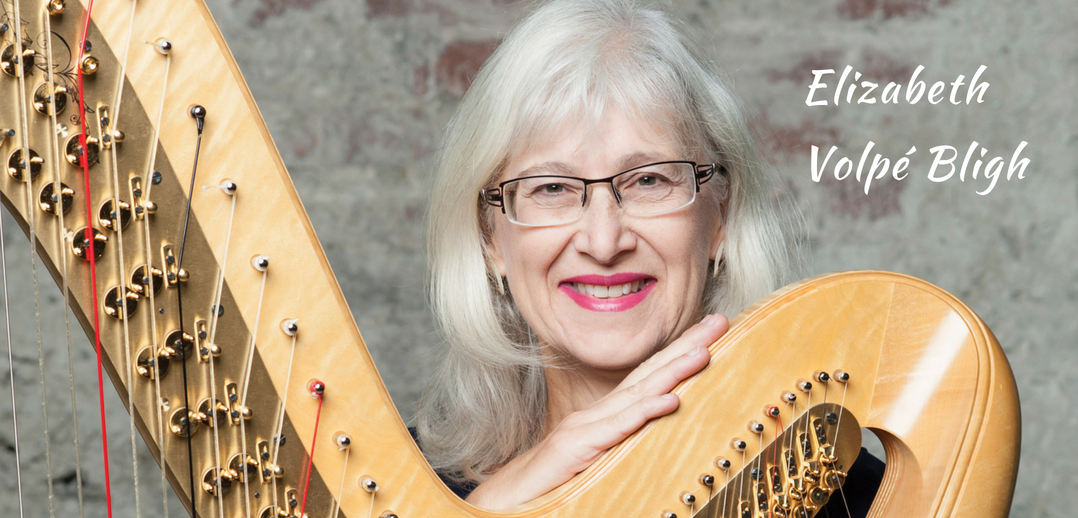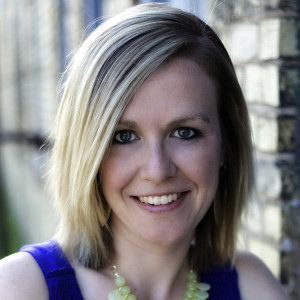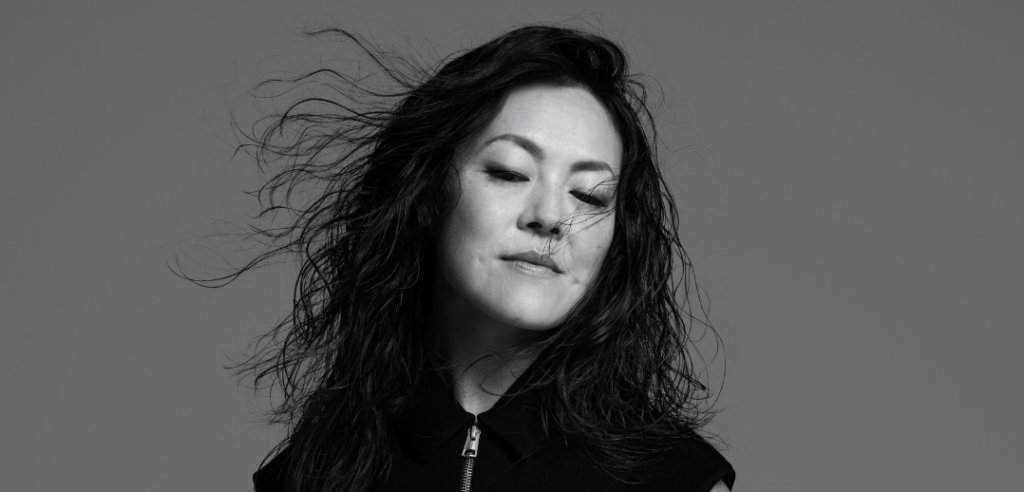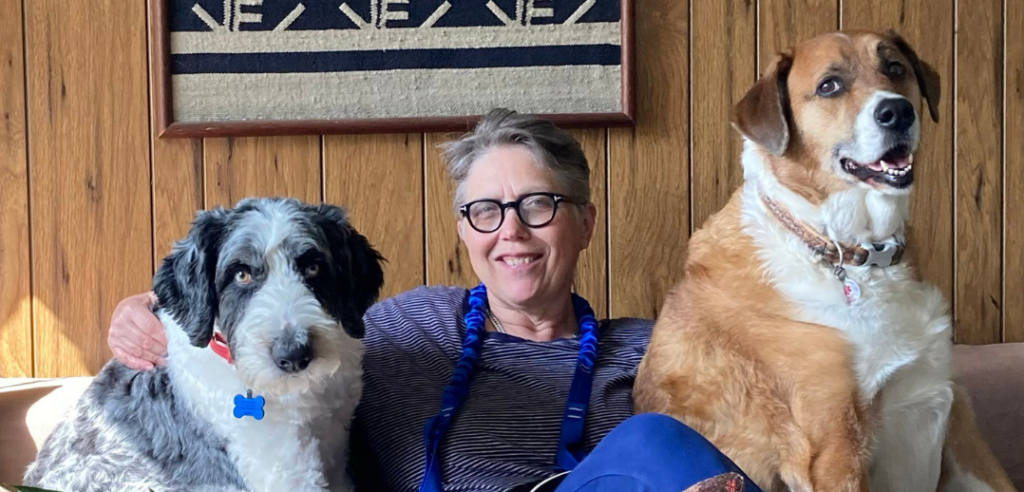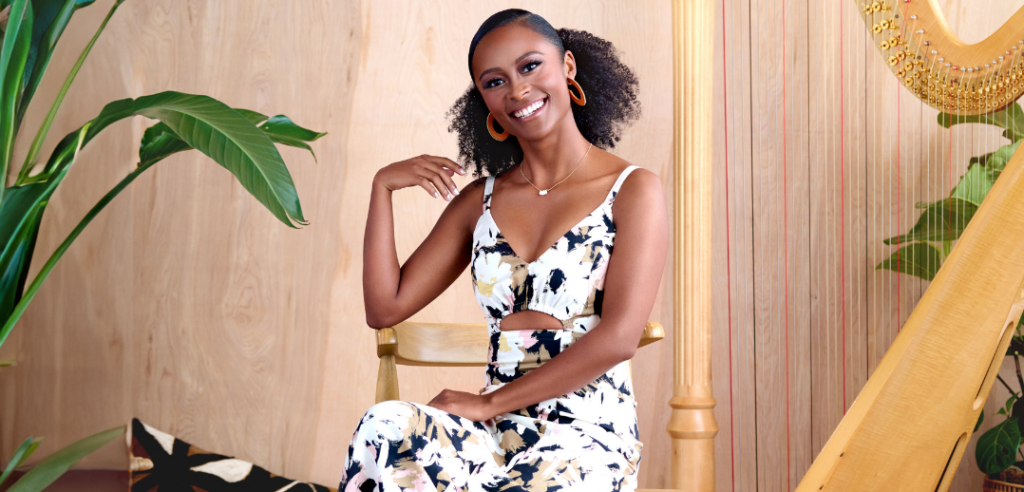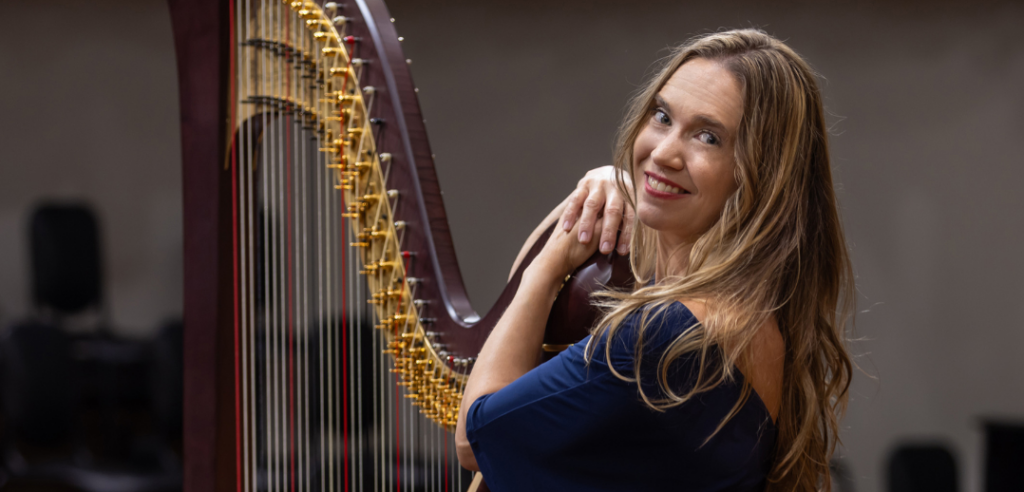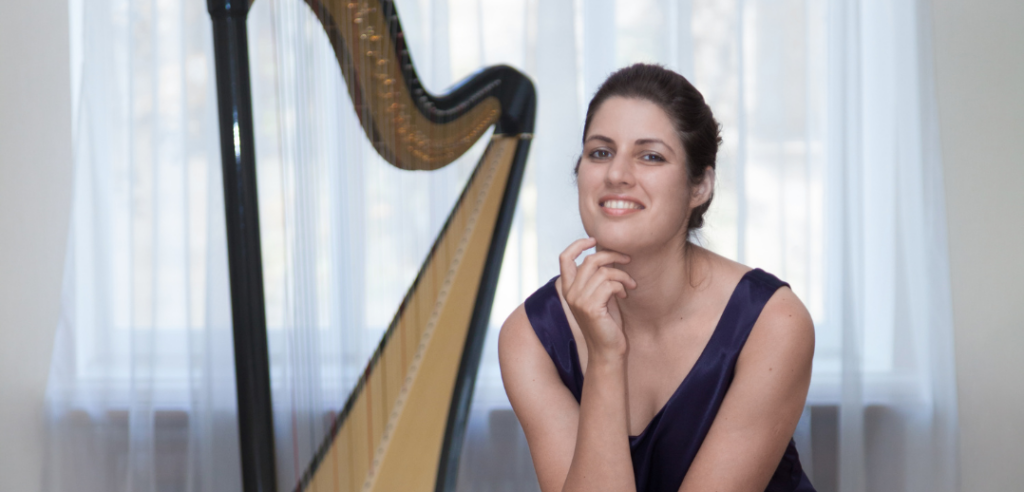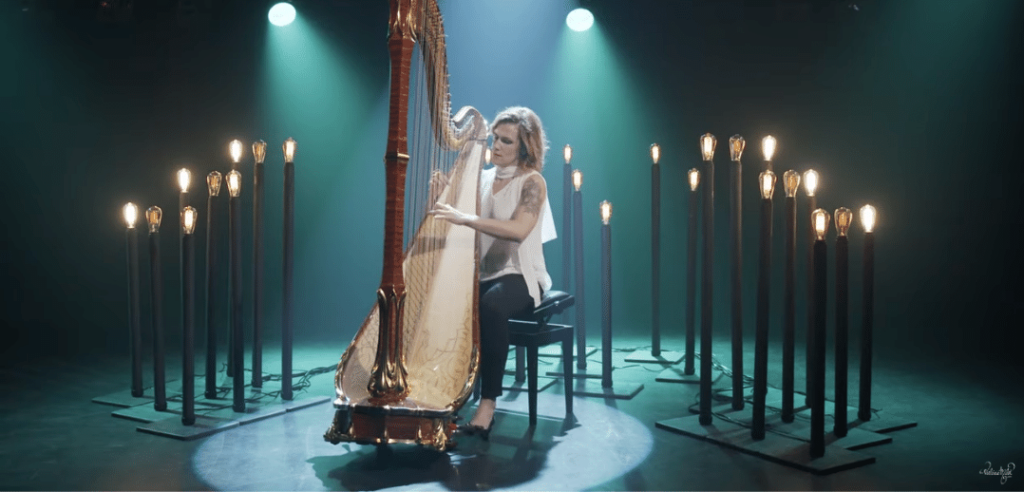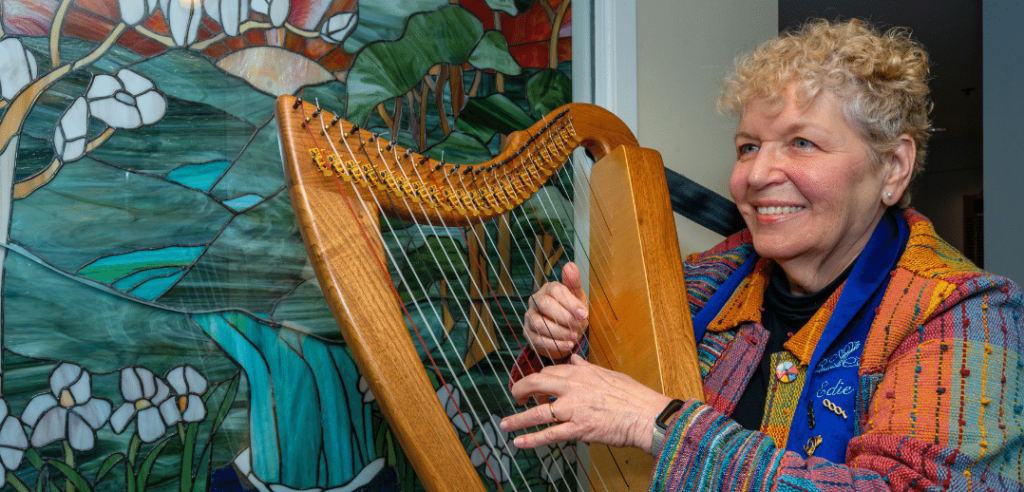If you are a longtime Harp Column reader, you probably recognize Elizabeth Volpé Bligh’s name from the many bylines she has had in the magazine over the years. Bligh’s analytical approach to the harp and wealth of orchestral experience has resulted in some of our favorite articles. There’s Cracking the Nutcracker, (September/October 2015), in which she shares some brilliant edits for the iconic harp part. Who could forget Top 10 Most Wanted Orchestra Parts, (November/December 2017), a must-read for orchestral harpists of every age. And then there’s my personal favorite, Mission Possible from our May/June 2014 issue, where Bligh shows how she breaks down seemingly impossible parts that land on harpists’ music stands in orchestra. It was in that 2014 article that Bligh shared her edits for the fourth movement of Bartok’s Concerto for Orchestra—a genius pedal hack, no let’s call it a “pedal reorganization,” that makes the perilous passage practically a walk in the park.
When Bligh announced her retirement from the Vancouver (B.C.) Symphony Orchestra (VSO) after more than 35 years last winter, we thought it was high time to give our readers a glimpse into the life and career of a harpist whose expertise she has graciously shared with us all. Bligh worked a Skype conversation with us into her busy schedule last spring as she was finishing out the end of the VSO’s season, after announcing her retirement in January.

Harp Column: After 35 yeares as principal harpist of the Vancouver Symphony, you are now retiring. What a big development in your life!
There’s something about seeing the light go on in a young person’s eyes—to see the excitement and enthusiasm as they transform into a good harpist.
Elizabeth volpé bligh: Yes, my reason for retiring was I just wanted to slow down a bit. Not that I hate playing with the orchestra—I love it still. The pace in the Vancouver Symphony is pretty insane. Maybe it’s like that for everyone now, I don’t know. Certainly ours is. It’s like a freight train: all this music coming at you all the time, and after a while it’s just enough already. So what I’ve done since retiring in January is take some things and let one of my colleagues take over if I want to take a week off here. We’re doing a Bernstein festival, and I thought, gosh, Bernstein is so difficult, I really need to be there for that. I’ve played it before, and someone new would be coming in learning this massive amount of music in a short amount of time. There’s a tour coming up, and I’m doing that. So I’m actually only quasi-retired until the orchestra holds an audition for the harp position.
HC: Have they scheduled the audition yet? Do you know how long it will be until you can be fully retired?
EVB: I did let all the Canadian harpists that I know of know that this was coming. And I went through the list of excerpts with the music director. I’ve okayed the list and sent it to everybody. It’s ready to go.
HC: I’m curious. You mentioned you’ve played all this Bernstein repertoire. You’ve pretty much played all the rep there is for orchestra, given that you’ve played for 35 years.
EVB: A lot of it yeah.
HC: If you had to pick a favorite composer to play what would you say? And what would you say makes you you cringe when you see it on the schedule because it might not be your favorite to play?
EVB: I would have to say my favorite is Mahler for the harp parts. They’re just so great. He seemed to understand the instrument so well. One of my harp teachers, Judy Loman, also said Mahler was her favorite for the same reason. Of course the French music—I love playing Daphnis and Chloe. It’s so much fun. Cringe? I think it’s probably the same thing that makes all of us cringe—like Tzigane. But it’s never gone badly. It’s just so much work getting it ready and wondering what the violinist is going to do because you have no control over that. If they suddenly shift there, you have to be with them. Other ones that make me cringe… well we do a lot of new music and some of those are crazy. It’s great to be doing new music. I think that we have to. There are some great pieces in there, but every so often we get one that’s, well, you know, millions of pedals changes.
HC: And you’re jumping all over the harp…
EVB: …and you eventually realize it’s just clusters and you could leave your feet on the floor and no one would know the difference.
HC: Before you were with the orchestra you were with the National Ballet Orchestra for six years. Was that job straight out of school?
EVB: Pretty much, yes. I had one post-graduate year in Cleveland. As I call myself an outpatient. I didn’t get a piece of paper. I just went and studied with Miss Chalifoux, and I snuck into a few classes I wasn’t supposed to be in. I just was paying for the private harp lessons. When I came back [to Canada], it was perfect timing. The person who had been playing the harp in the National Ballet, Dorothy Weick, just had had enough of it, so she left. Her position was suddenly open, and I happened to get back to Toronto just when that happened. I got this frantic phone call, “Can you come in?” I never played any of the rep before—I was 22 years old—and we were going on a six-week tour with Rudolph Nureyev. We had at least six or seven ballets, and I had to learn all this stuff within a week or two and go on tour with it. It was kind of a trial by fire.
HC: I should say so. Then you went from there to Vancouver for the next 35 years. What do you think it’s going to feel like at some point next season when you wake up and don’t have to go to rehearsal?
EVB: Yay! I’m not going to stop playing, by any means. I have all this music sitting here collecting dust because I never had any time to get to it. I thought, this is the time to learn the solos that have been written for me that are sitting there not going anywhere. I found a piece by Quincy Porter for violin, viola, and harp that I’ve had since I was in my 20s. It’s time to learn it. I’m also taking more students. I have more students at UBC next year, so I’ll be busy.
HC: Sounds like it. Maybe more busy than now; you never know.
EVB: Yes, probably. [Laughs]
HC: From an entire career playing in orchestras, you’ve developed this wealth of knowledge about how to be an artist with your own musical ideas and an ensemble player at the same time. You’ve always been very generous in sharing your advice with others, especially with young students. Can you share with our young readers your best advice for playing in an ensemble as a harpist?
[pullquote]Bligh, who didn’t start playing the harp until she was 17 years old, says she did things backwards. When she was first learning how to play, she dove into major repertoire before she had cemented her technique. “You really should have the technique in place before you start doing all that stuff,” she says. “I think that’s why I’m so analytical, why I teach my students every little step, because I remember it all…I remember all the steps I had to do to make it work.”[/pullquote]
EVB: Definitely. You have to have your ears open. Many people go on a track where they learn their part, they play their part, but they’re not listening to what’s going on around them. There’s rubato and the wind players take breaths, and you have to wait for them sometimes. Sure, you look at the conductor, but sometimes they’re not all that clear. On top of watching the conductor, you have to listen like crazy. And also if you can listen to a recording before the first rehearsal, that’s huge.
HC: Do you think there’s anything different about playing in an ensemble as the only harpist, as opposed to being part of a section day in and day out?
EVB: I used to play the flute.
HC: Do you approach the job differently as a harpist than you did as a flutist?
EVB: It is really different. Playing the flute for example, you’ve got your fingers already on the flute. You’re not having to look at your hands because everything is within a centimeter of whatever you’re going to be doing and if you have to go up an octave you do it with your lip and you move it an eighth of an inch. Everything is physically close. All you have to do is read your line of music and there’s only so many fingerings you can use on a flute. You see a G on the page, and your hands do the same fingering every time or some trick fingering. So you can read music really fast and all you have to do is look at the conductor, and he’s right in front of you. You’re right in the middle of the orchestra. You have your friends around you. You have your section. I shouldn’t say it’s easier because you have to coordinate your lips, and your tongue, and all that stuff. But the actual playing in the orchestra is so much easier. It’s so much less multi-tasking than playing the harp. With the harp, most people have to look at their strings occasionally, especially if you have a big jump. Unless you’re like Sasha Boldachev and can play in the dark. Most of us do have to occasionally take a peek at what we’re doing and make sure that we’re not going to miss. You’re dealing with a lot of variables—your pedals can go awry, you’re trying to read eight notes at a time. It’s like reinventing the wheel every time you get a new piece; you have to figure out new fingerings. There are many more tasks involved in getting a harp part ready than there are for a single-line part.
HC: How about in terms of the ensemble aspect?
EVB: Again, when you’re in a flute section, or any kind of section I suppose, you have to listen to your partners like crazy, and you have to tune to them. We don’t have to do that as harpists, at least. You also have to make decisions about where everyone is going to breathe. You do it there, I’m going to do it there so it doesn’t sound like we’re breathing at all. They also mix up parts, which I like to do as well—I picked that up from flute playing. You don’t have to play necessarily what you see on the page. If you have a second flute, and there’s no place to breathe, you say, “Okay, I’m going to play till here. You take over here, and then I’m going to come back in here.” Then there’s no problem. So with the harp, I do a lot of that as well [if there’s a second harpist]. “I take this; you take that. Now we don’t have any pedal changes, yay!”
HC: You have created a lot of edits for harp parts—tricky spots, unplayable measures. What are some of your favorite edits or fingerings that you’ve come up with, the ones that make you think, “Ah, I really corralled that part.”?
EVB: The Flying Dutchman overture—I have a great hack for that. I also made it easier to play the Romeo and Juliet Fantasy overture by Tchaikovsky, even though that’s not really that difficult. There are ways to make it even easier. By changing some of the notes, it sits more comfortably in the fingers. Things like that. Bartok’s Concerto for Orchestra, the fourth movement—that’s the accomplishment I’m most proud of. I took out millions of pedal changes, and it’s so much easier. But it’s exactly the same—nothing is missing. Anything that’s really pedally I just re-spell it and write it out so I’m not having to read a bunch of circled [enharmonic] notes, because I hate that.
HC: You are always so willing to share what you’ve learned and what you’ve figured out with other harpists. What drives that desire to help your peers?
EVB: I realized at one point that a lot of people were working much, much harder than they needed to, and I thought, I’ve got this. Why am I hanging on to this? Spread it around. Especially with my students, I tell them if they have something really difficult to play, check with me. I might have something that helps. Also, I just wanted to spread the philosophy that you don’t have to die on the mountain. There’s so many ways to get around this. The main thing to ask yourself is does it sound good in the orchestra? You want the orchestra to sound good. It doesn’t matter if you’re playing everything—that is a matter of personal pride. If you have a second harpist sitting there who can help, or if you can find a way to make it easier, that’s all good. That makes the orchestra sound better. You feel more comfortable. It’s a win-win.
HC: Right. Then everybody plays better.
EVB: Obviously when you’re playing alone in an audition that’s a whole different ball game, but once you’re on the job…
HC: I’m struck by the physical stamina that it takes to do a job like you’ve had for 35-plus years. Tell us what you’ve done in the physical approach to the harp to have that kind of stamina to do this job for that many years.
EVB: Actually, fairly recently I’ve taken up weight lifting. I’m not naturally strong; I’m kind of a wimp. I would get into these situations like the “Berceuse” from Firebird when you’re doing all those harmonics and your arm starts to feel like it’s going to fall off by the end of it. I thought, that’s not good; I should be stronger. Now the “Berceuse” is fine. It doesn’t bother me, and I realized it’s something I had to address, and I should have done it years ago. I used to get into the gym once in a while, and then I’d fall off the wagon and have to get back on. About three years ago, I got cripplingly sick with lupus and had to quit for months. Coming back from that, I got a personal trainer and learned all these great exercises. My playing is actually even better now than before I got sick.
HC: No kidding?
EVB: Yes, I have more strength. But also, I take naps. If it’s a really long day, I just have to go and have a nap. There’s no way I could keep going without it. Maybe that’s why I came up with all these edits, because you do get exhausted.
HC: Absolutely. And not only is the actual physical playing of the part exhausting, but so is, like you said at the outset of the interview, the pace of music being thrown at you in an orchestra. Can you talk about how strenuous a full-time orchestra season can be?
EVB: We have a new music festival now, and I’ll have five different folders on your stand—all new music—which I have to learn within a very short period of time. You’ve never seen any of it before. A normal week for the Vancouver Symphony has at least two programs in it, sometimes three. That’s normal. Once in a while, we get a week off. It’s not really a week off because we have all this other music coming, and we just want to get at it, so we can’t really go anywhere. It’s not even really a vacation. We only get a couple of days off a week but we don’t even get that sometimes, we get one day off. That’s our teaching day. So we don’t get a day off at all. The two days off don’t come consecutively either. We’re guaranteed Tuesday off, then your other day might be somewhere else along the line. It’s a minimum of eight services a week. When they say services that’s a two-and-a-half hour call. But it’s not the number of services, it’s the amount of rep that we have to get through. Like this Bernstein Festival, we’re doing all the big Bernstein stuff—different programs in a short period of time—Age and Anxiety, Candide, Serenade, Chichester Psalms, West Side Story, Symphonic Dances paired with Mahler 4. We’re just kind of crazy trying to get everything so it sounds good.
HC: Switching gears, I wanted to talk about your teaching because that’s been a big part of your career and will continue to be. Tell us what you love about teaching.
EVB: I do love it; that’s why I want my career to move more towards the teaching now. There’s something about seeing the light go on in a young person’s eyes—to see the excitement and enthusiasm as they transform into a good harpist. It’s just a wonderful thing to watch a little kid do that. I have this kid who’s been playing lever harp for quite some time and has a lovely little technique. She just got her first pedal harp in September, and by November she was playing Symphony Fantastique with the youth orchestra. It was amazing. Then she did Magic Fire Music after that. Going from a lever harpist to Magic Fire Music in just a matter of months was amazing to see.
HC: That is incredible.
EVB: To be a harp student, you have to want it. Once in a blue moon you get the kid who’s been pushed into it by their parents, but it’s rare. I mean how many parents say, “I think I’d like to buy you a harp and make you play it.”
HC: Tell us how you got started playing the harp.
EVB: As you know I was a flute player, and I started on piano, like a lot of people do. There wasn’t a piano in the house, come to think of it. Our neighbor had one, and I used to go to her house and clunk around on her piano. The neighbor said to my mother, “You need to get your kid a piano.” It was just one of those things I was born with—this musical gene—and I just had to have music in my life. So I started playing piano, and then I got into flute in school. I got into the Toronto Youth Orchestra. I tried to get into the National Youth Orchestra on flute, but there were hundreds of people applying, and I realize it was not going to happen. I was in the Toronto Youth Orchestra, so that wasn’t bad, but it wasn’t enough for me. I wanted to get to the top. I looked around and thought, nobody’s playing the harp. Maybe I should switch. From piano to harp it can’t be that difficult.
HC: How old were you when you switched?
EVB: I was 17. As it happened, I was at the Toronto Conservatory for a flute lesson. Right beside my flute teacher’s door there was a bulletin board. On the bulletin board was a little note advertising a harp for sale with a telephone number. I said, “Hey mom, can we stop at this lady’s house and look at this harp for sale?” And she said okay, so we stopped, and she had this beautiful old gold [Lyon & Healy] 22 for sale for $3,000. That was in 1969 or something, so that was a lot of money back then. My mother wrote a check and we took it home.
HC: No kidding!
EVB: We didn’t think Judy Loman would take me. We assumed she only took really good students, you know. So I started with somebody else, and after three months I thought, I need a really good teacher. So we called Judy Loman, and she said, “Well, I wish you had called me first. Now I’m going to have to start her back again at the beginning.” So I started with Judy and went from there. I just jumped in the deep end. We used to have grade 13 in Ontario, so I was in grade 13 and I went into music. This was the funny thing, I got into the University of Toronto on flute. I auditioned on the flute. Was accepted. Then the week after that I went into the dean’s office and said, “I’d like to switch my major.” He said, “No, you can’t do that; you’re a flute major. What do you want to switch to?” I said, “Harp.” He said, “Okay, come back. Sign here.”
HC: Wow.
EVB: They only had one other harp major, and I guess they were really hoping to have more. I dove in. The other girl was really good. I thought she could take all the difficult stuff, and I’ll just learn how to play, but then she dropped out. So there I am learning Tristan and Isolde after one year of harp playing.
HC: Talk about being thrown into the deep end.
EVB: I had to learn how to fake right off the bat because I did not have the technique for the rep I was playing. I had my piano training and my flute training and I made it all work. I knew how to tune. I was good at tuning. I was great at counting. My rhythm was super strong because I had Kodály and Orff training when I was growing up. I was really lucky the music in my elementary school was amazing.
HC: This was in Toronto. You grew up in Toronto, right?
EVB: Yes, it just happened. I didn’t realize our school was unique in this fabulous music program we had. It just happened that way.
HC: How lucky.
EVB: We were bouncing balls to rhythm and counting and doing all that Kodály stuff. I didn’t know that was brand new at the time.
HC: That would have been very cutting edge.
EVB: Kodály was just inventing that.
HC: That’s amazing
EVB: I dove right in, did the best I could, played operas, did everything. Judy Loman was tearing her hair out because I just developed my own technique at the time. After this was all over, I had gotten my degree, and then Judy said, “You need to go and study with Alice Chalifoux.” I studied with her every summer at the Salzedo Harp Colony just trying to get my technique into shape. Then I got that job at the ballet, so all the way through there I was building technique. It was really a backwards way to do things. You really should have the technique in place before you start doing all that stuff.
HC: Ideally.
EVB: I think that’s why I’m so analytical, why I teach my students every little step, because I remember it all. It happened to me so late in life that I remember all the steps I had to do to make it work.
HC: Right, much different than how you learn as a young child. You just know how to do it but you have no memory of what it took to get there. That’s interesting. Very interesting. I’m curious, today if you could give some advice to your younger harp self, say 18-year-old Elizabeth, what would you tell her?
EVB: I would say, “Listen to your teacher.” Judy said, “You should take a year off before you go to university and just work on technique.” And I said “Oh no, I’m just going to get on with this.” She should have just slapped me. I would tell my younger self to do nothing but scales and arpeggios and etudes, and just get it together before you dive in. But timing is everything, and, in a way maybe it was good that I did that because I just kind of sucked it up and did it. It worked in the long run, but it was kind of miserable not having the technique and just having to invent it on the fly.
HC: Yes, I’m sure.
EVB: I was an idiot. I did the Debussy Dances. I did the Handel Concerto with community orchestras and got good reviews. I wish I had recordings so I could listen to what it actually sounded like.
HC: That’s interesting. It speaks to your level of musicianship that, without that technique, you were able to support it and pull that off. Clearly you had a solid musical foundation.
EVB: The foundation was everything. I was working on my [Associated Board of Royal Schools of Music] grade 10 piano when I stopped playing piano. So I was already doing Bach fugues and all that stuff on piano, and I just felt like the harp was a piano turned sideways.
HC: You studied with Judy and also Alice Chalifoux. Did you study with Edna Phillips at all?
EVB: Yes, she came to the Salzedo Harp Colony while I was there, and I would have lessons alternately with Alice and Edna when she was there. That was awesome because they were yin and yang. Miss Chalifoux was, “Get your elbows up. Get your thumbs up,” that sort of thing. Whereas Ms. Phillips was all about the phrasing and the tone. She even said, “I don’t care if you play with your nose as long as it’s beautiful.” This is fabulous—a completely complementary way of teaching so you get two completely different approaches. They were really good friends. They were so respectful. It was really ideal.
HC: What sort of lasting influence do you think each of your three teachers had on you?
EVB: Judy was my main teacher, and her level of playing is so extraordinary—it’s such an inspiration. I would just listen to that and think, if I could achieve even half of that, it’s just so incredible. The tone and cleanliness—she never buzzes—and her interpretation is just beautiful. And also she wouldn’t accept that I could play any less than my best. Miss Chalifoux was just so brilliant and creative with her fingerings. She sort of got me on that road of thinking, just because it looks like this on the page doesn’t mean you have to play it that way. The way she taught was extremely analytical, and I got that from her, breaking everything down into its components. She also had her little prescription pieces. So if a student is having this problem, then play this piece. And then, of course, Ms. Phillips, with her enormous musicianship and generosity, letting you try different techniques to get the sound you’re looking for. They were all just tremendous. I loved them all. •





